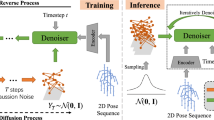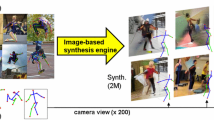Abstract
In this paper, we propose a method for generating joint angle sequences toward unsupervised 3D human pose estimation. Many researchers have proposed human pose estimation methods. So far, however, most methods have problems that require a large amount of images with supervised pose datasets to learn pose estimation models. Building such datasets is a time-consuming task. Thus, we aim to propose a method that can estimate 3D human poses without requiring training data with known poses. Toward this goal, we propose a GAN-based method for human motion generation and an optimization-based human pose estimation method. The proposed method consists of a generator that generates human pose sequence, a renderer that renders human images by changing 3D meshes based on the pose sequences generated, and a discriminator that discriminates between generated images and training data. Through an experiment based on simulated walking images, we confirmed that the proposed method can estimate the poses of body parts that are not occluded.
Access this chapter
Tax calculation will be finalised at checkout
Purchases are for personal use only
Similar content being viewed by others
References
Kanazawa, A., Black, M.J., Jacobs, D.W., Malik, J.: End-to-end recovery of human shape and pose. In: Proceedings of the IEEE Conference on Computer Vision and Pattern Recognition, pp. 7122–7131 (2018)
Kato, H., Ushiku, Y., Harada, T.: Neural 3D mesh renderer. In: Proceedings of the IEEE Conference on Computer Vision and Pattern Recognition, pp. 3907–3916 (2018)
Kulkarni, T.D., Kohli, P., Tenenbaum, J.B., Mansinghka, V.: Picture: a probabilistic programming language for scene perception. In: Proceedings of the IEEE Conference on Computer Vision and Pattern Recognition, pp. 4390–4399 (2015)
Liu, Z., Zhu, J., Bu, J., Chen, C.: A survey of human pose estimation: the body parts parsing based methods. J. Vis. Commun. Image Represent. 32, 10–19 (2015)
Loper, M., Mahmood, N., Romero, J., Pons-Moll, G., Black, M.J.: SMPL: a skinned multi-person linear model. ACM Trans. Graph. (TOG) 34(6), 248 (2015)
Martinez, J., Hossain, R., Romero, J., Little, J.J.: A simple yet effective baseline for 3D human pose estimation. In: International Conference on Computer Vision, vol. 1, p. 5 (2017)
Moreno-Noguer, F.: 3D human pose estimation from a single image via distance matrix regression. In: 2017 IEEE Conference on Computer Vision and Pattern Recognition (CVPR), pp. 1561–1570. IEEE (2017)
Murray, M.P., Kory, R.C., Clarkson, B.H., Sepic, S.: Comparison of free and fast speed walking patterns of normal men. Am. J. Phys. Med. Rehabil. 45(1), 8–24 (1966)
Radford, A., Metz, L., Chintala, S.: Unsupervised representation learning with deep convolutional generative adversarial networks (2015). arXiv preprint arXiv:1511.06434
Sarafianos, N., Boteanu, B., Ionescu, B., Kakadiaris, I.A.: 3D human pose estimation: a review of the literature and analysis of covariates. Comput. Vis. Image Understand. 152, 1–20 (2016)
Takemura, N., Makihara, Y., Muramatsu, D., Echigo, T., Yagi, Y.: Multi-view large population gait dataset and its performance evaluation for cross-view gait recognition. IPSJ Trans. Comput. Vis. Appl. 10(4), 1–14 (2018)
Tan, J., Budvytis, I., Cipolla, R.: Indirect deep structured learning for 3D human body shape and pose prediction. In: Proceedings of the BMVC, London, UK, pp. 4–7 (2017)
Toshev, A., Szegedy, C.: Deeppose: human pose estimation via deep neural networks. In: Proceedings of the IEEE Conference on Computer Vision and Pattern Recognition, pp. 1653–1660 (2014)
Tran, D., Bourdev, L., Fergus, R., Torresani, L., Paluri, M.: Learning spatiotemporal features with 3D convolutional networks. In: Proceedings of the IEEE International Conference on Computer Vision, pp. 4489–4497 (2015)
Tung, H.Y., Tung, H.W., Yumer, E., Fragkiadaki, K.: Self-supervised learning of motion capture. In: Advances in Neural Information Processing Systems, pp. 5236–5246 (2017)
Acknowledgement
This work was supported by JSPS KAKENHI Grant Number JP17K00372 and JP18K11383.
Author information
Authors and Affiliations
Corresponding author
Editor information
Editors and Affiliations
Rights and permissions
Copyright information
© 2020 Springer Nature Singapore Pte Ltd.
About this paper
Cite this paper
Yamane, S., Yamazoe, H., Lee, JH. (2020). Human Motion Generation Based on GAN Toward Unsupervised 3D Human Pose Estimation. In: Cree, M., Huang, F., Yuan, J., Yan, W. (eds) Pattern Recognition. ACPR 2019. Communications in Computer and Information Science, vol 1180. Springer, Singapore. https://doi.org/10.1007/978-981-15-3651-9_10
Download citation
DOI: https://doi.org/10.1007/978-981-15-3651-9_10
Published:
Publisher Name: Springer, Singapore
Print ISBN: 978-981-15-3650-2
Online ISBN: 978-981-15-3651-9
eBook Packages: Computer ScienceComputer Science (R0)




